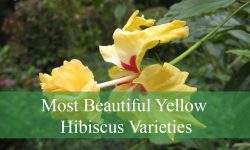When it comes to landscaping, small evergreen shrubs are an excellent choice for adding structure, texture, and year-round greenery to your garden. If you’re looking to create a low-maintenance border, a lush ground cover, or a small hedge, these versatile plants are perfect for various purposes. With their ability to retain foliage throughout the seasons, small evergreen shrubs bring life to any outdoor space, no matter the climate.
Small evergreen shrubs offer a wide range of benefits. Not only do they provide consistent color and form, but they also help with soil erosion control and provide habitat for local wildlife. They come in various shapes, sizes, and colors, making it easy to find one that complements your garden’s aesthetic. From flowering varieties to those with vibrant foliage, there’s a small evergreen shrub for every garden style.
In this article, we will explore 43 small evergreen shrubs, showcasing their unique features, growing habits, and ideal planting conditions. If you’re an experienced gardener or a beginner looking to enhance your landscape, these plants are a fantastic option. Keep reading to discover the perfect small evergreen shrubs to transform your garden into a beautiful and functional space year-round.
Small Evergreen Shrubs in North America
Ilex glabra (Inkberry Holly)
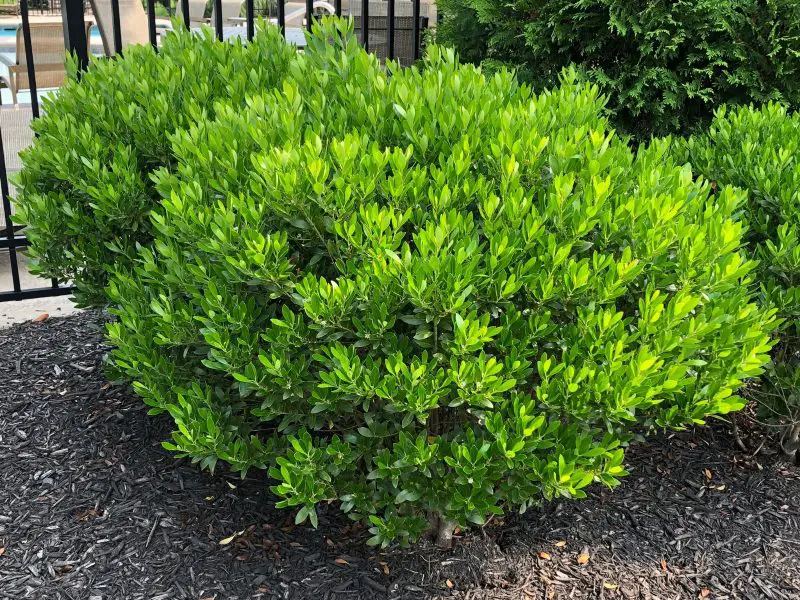
Ilex glabra, commonly known as Inkberry Holly, is a small evergreen shrub native to the eastern United States. It typically grows 3 to 5 feet tall and forms a rounded, compact shape with dense, dark green foliage that remains vibrant year-round. Unlike many hollies, it has smooth-edged, spineless leaves and produces small, black berries on female plants in late summer, which persist into winter and attract birds.
This shrub is easily identified by its lustrous foliage and inconspicuous greenish-white flowers that bloom in late spring. Inkberry Holly prefers acidic, moist to wet soils and is highly tolerant of poorly drained areas, making it ideal for rain gardens and wetland borders. It thrives in USDA hardiness zones 4 to 9 and tolerates both full sun and partial shade.
Inkberry Holly is commonly used in foundation plantings, hedges, and mass plantings. It requires minimal maintenance, although pruning may help shape and renew older shrubs. It benefits from mulching and consistent watering during dry spells. Its dense habit and adaptability to different soil types make it a valuable plant for naturalistic landscapes and erosion control.
Rhododendron ‘PJM Elite’ (PJM Rhododendron)
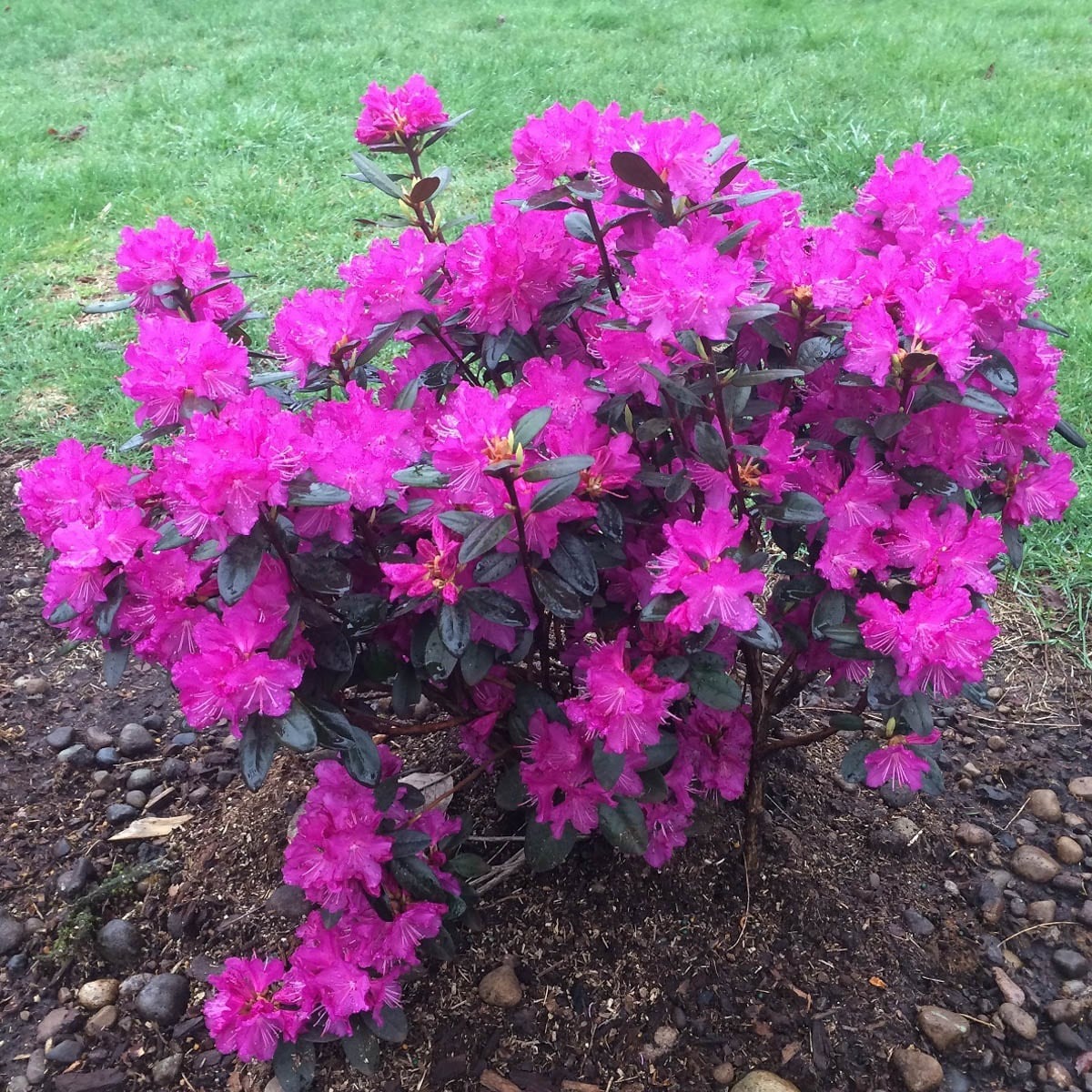
Rhododendron ‘PJM Elite’ is a cold-hardy hybrid rhododendron celebrated for its showy lavender-pink blooms and evergreen foliage. It typically grows 4 to 6 feet tall with a rounded form and dense branching. The leathery leaves take on a purplish-bronze hue in winter, providing year-round interest in the garden.
This cultivar is best recognized for its early spring bloom, when masses of bright flowers cover the shrub before new leaves emerge. ‘PJM Elite’ prefers acidic, well-drained soil rich in organic matter and grows best in partial shade. It is hardy in USDA zones 4 to 8 and can tolerate colder climates better than many other rhododendrons.
In landscaping, ‘PJM Elite’ is often used as a specimen plant or in mixed borders. It requires minimal pruning and benefits from annual mulching and protection from harsh winter winds. This rhododendron is also valued for attracting pollinators and providing a vibrant splash of color at the start of the growing season.
Arctostaphylos uva-ursi (Bearberry)
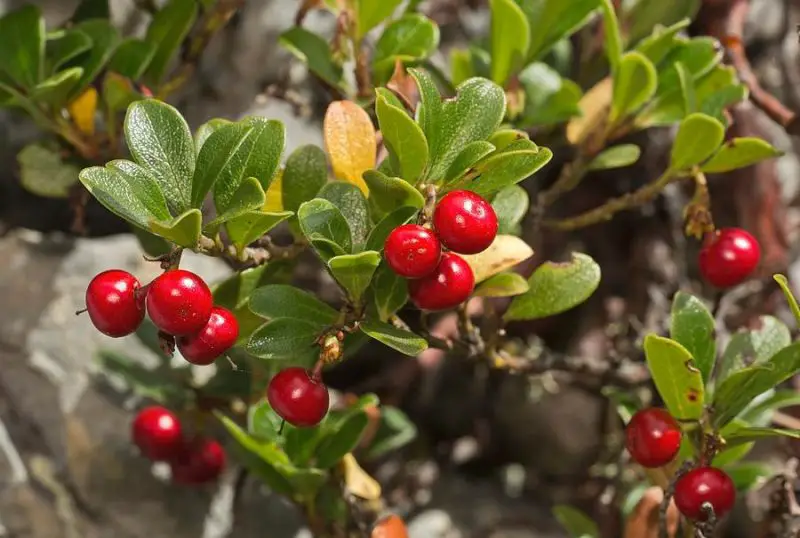
Arctostaphylos uva-ursi, commonly known as Bearberry, is a low-growing evergreen shrub native to northern North America and parts of Europe and Asia. It typically spreads 3 to 6 feet wide while remaining under 1 foot tall, forming a dense, ground-hugging mat of leathery, dark green leaves. In spring, it produces clusters of small, urn-shaped pink or white flowers followed by red berries in fall.
Bearberry is easily identified by its trailing stems and glossy, spoon-shaped leaves that turn reddish-bronze in winter. It thrives in sandy, well-drained soils and is highly drought-tolerant once established. This shrub is suitable for USDA zones 2 to 6 and performs well in full sun to partial shade, particularly in colder climates.
Bearberry is commonly used in rock gardens, slopes, and naturalized areas due to its erosion control properties and groundcover capabilities. It requires minimal care beyond occasional watering and pruning to manage spread. Its berries are a food source for wildlife, and its evergreen foliage provides excellent winter interest.
Mahonia repens (Creeping Mahonia)
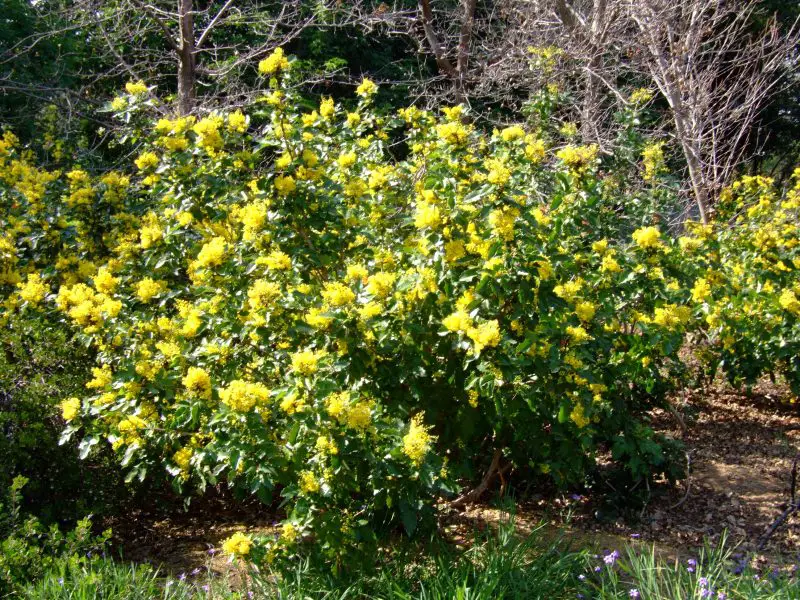
Mahonia repens, also known as Creeping Mahonia or Creeping Oregon Grape, is a native evergreen shrub found across western North America. It grows up to 1 to 2 feet tall and spreads by underground stems to form colonies. Its leathery, holly-like leaves emerge with a reddish tinge and mature to dark green, turning purplish-bronze in winter.
This plant is identifiable by its compound leaves and clusters of bright yellow flowers that bloom in early spring, often before many other plants awaken. These blooms are followed by small, blue-black berries in summer. Creeping Mahonia prefers well-drained, slightly acidic soil and thrives in USDA zones 5 to 9. It tolerates dry, shady locations and is highly adaptable to forest understories and dry slopes.
Creeping Mahonia is ideal for groundcover in woodland gardens, erosion control on slopes, or naturalized plantings. It requires little maintenance, apart from occasional thinning to prevent overcrowding. Its ornamental foliage, early blooms, and wildlife value make it a multifunctional addition to native and xeriscape gardens.
Spiraea japonica (Japanese Spiraea)
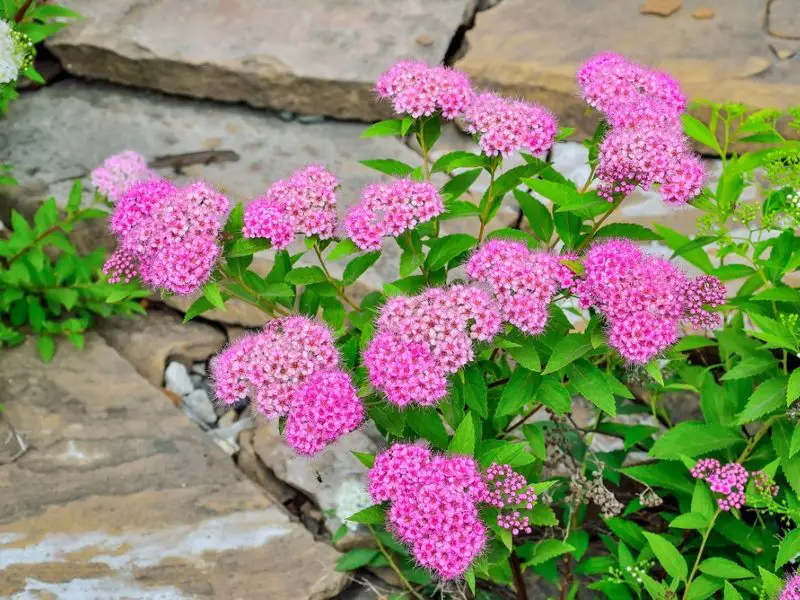
Spiraea japonica, or Japanese Spiraea, is a deciduous shrub widely grown for its vibrant flower clusters and compact growth habit. It typically reaches 2 to 4 feet in height and spread, with dense, upright stems and small, oval leaves that may take on reddish or bronze tones when young. The plant blooms profusely in late spring to summer with flat-topped clusters of pink, rose, or white flowers.
This shrub is easily recognizable by its long blooming period and fine-textured foliage, which may turn yellow or reddish in fall. Japanese Spiraea grows well in average, well-drained soils and thrives in full sun. It is adaptable and performs reliably in USDA hardiness zones 4 to 9, tolerating a variety of soil conditions and urban environments.
In landscaping, Japanese Spiraea is often used in borders, low hedges, or mass plantings for continuous color and structure. It benefits from hard pruning in late winter to encourage vigorous new growth and improved flowering. Drought-tolerant once established, it is a versatile and easy-care choice for pollinator gardens, public landscapes, and residential yards.
Cotoneaster dammeri (Bearberry Cotoneaster)
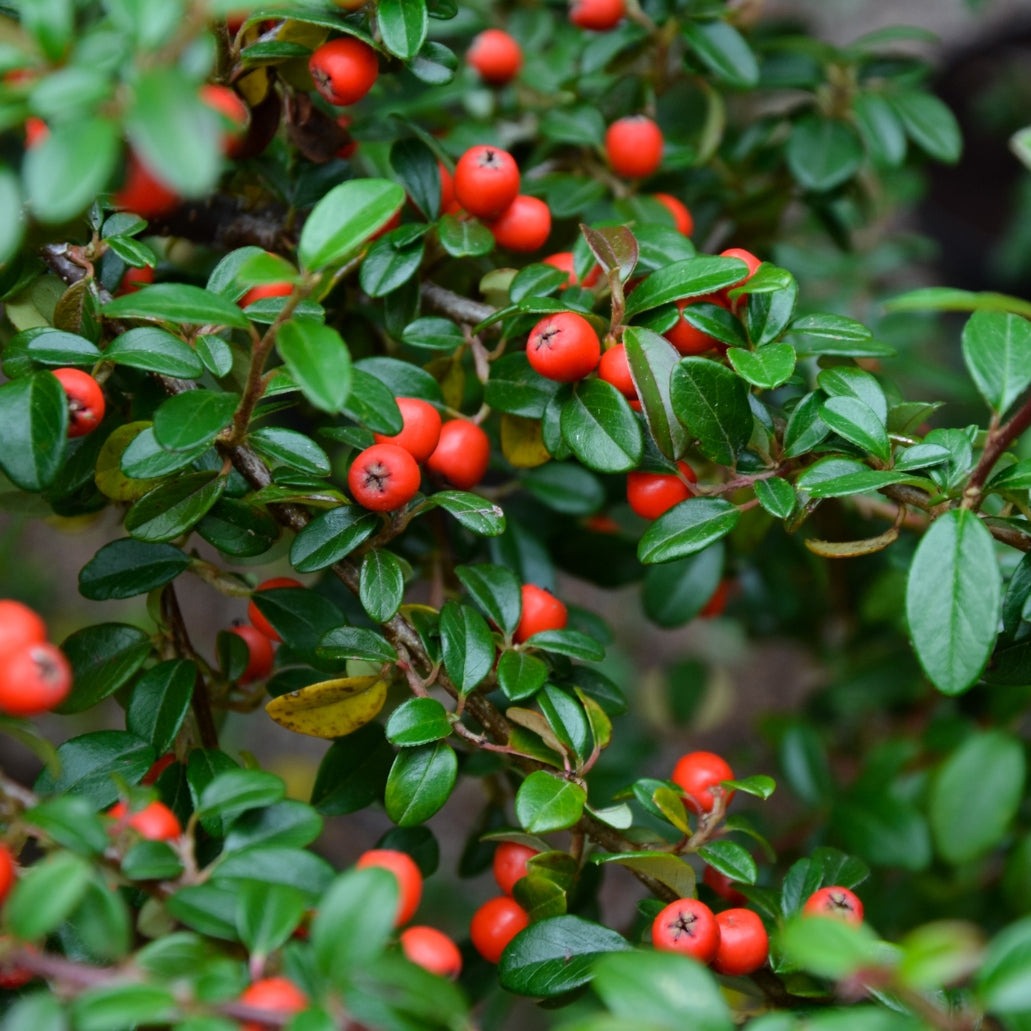
Cotoneaster dammeri, commonly known as Bearberry Cotoneaster, is a low-growing, evergreen shrub prized for its spreading habit and ornamental appeal. It typically grows 1 to 2 feet tall but can spread 5 to 6 feet wide, forming a dense mat of glossy, dark green leaves. In spring, it produces small white flowers followed by bright red berries in fall that persist into winter.
This shrub is easily identified by its arching stems, rounded leaves, and the combination of flowers and berries that attract pollinators and birds. Bearberry Cotoneaster thrives in well-drained soil and full sun to partial shade. It is hardy in USDA zones 5 to 8 and is drought-tolerant once established, making it ideal for low-maintenance gardens.
Often used as groundcover on slopes or in rock gardens, Bearberry Cotoneaster is valued for its erosion control and year-round interest. It requires little care aside from occasional pruning to manage spread or maintain shape. Its adaptability, attractive foliage, and wildlife-friendly berries make it a practical and decorative choice for various landscape settings.
Ceanothus americanus (New Jersey Tea)
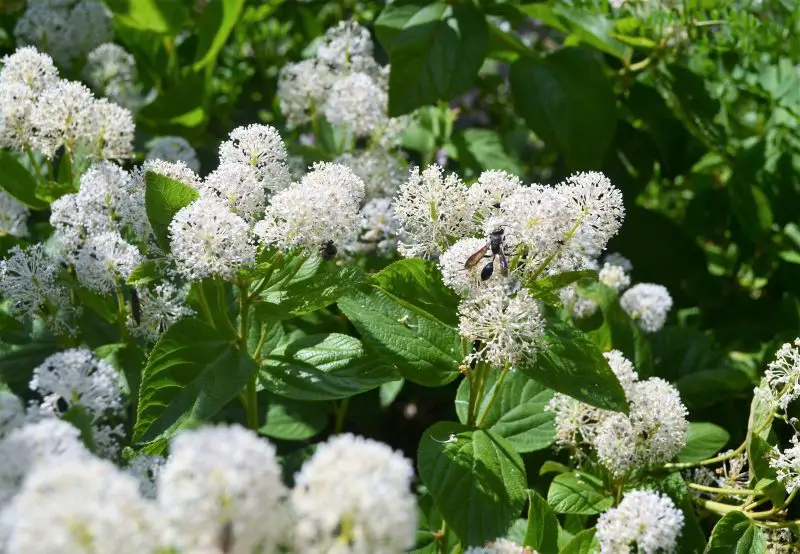
Ceanothus americanus, commonly known as New Jersey Tea, is a compact deciduous shrub native to eastern and central North America. It grows up to 3 feet tall with a rounded form and features deep green, ovate leaves. In early to midsummer, it produces clusters of small, fragrant white flowers that are highly attractive to butterflies and bees.
This plant is recognizable by its profuse summer blooms and its ability to fix nitrogen in the soil. New Jersey Tea prefers dry to medium, well-drained soils and full sun to part shade. It is hardy in USDA zones 4 to 8 and is well-suited for prairie-style plantings, native gardens, and low-water landscapes.
New Jersey Tea is an excellent choice for pollinator gardens, borders, or naturalized areas. It requires minimal maintenance, is drought-resistant, and tolerant of poor soils. Historically, its leaves were used as a tea substitute during the American Revolution, adding a touch of cultural heritage to its practical and ornamental landscape value.
Chamaecyparis pisifera ‘Filifera’ (Threadleaf Cypress)
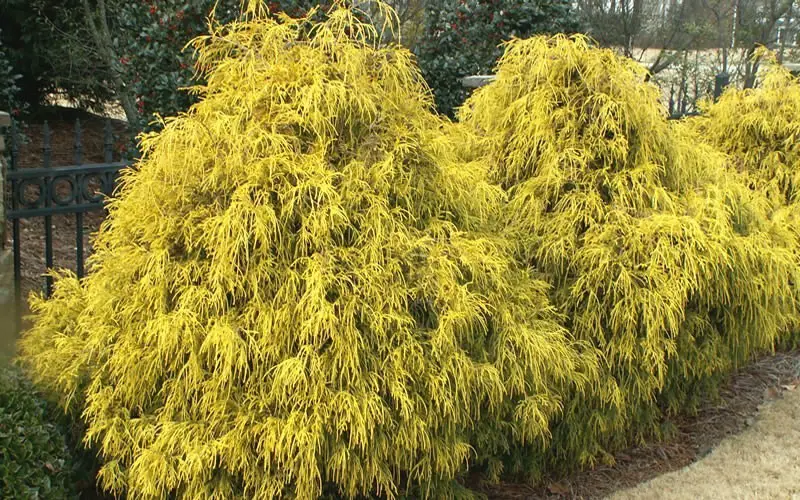
Chamaecyparis pisifera ‘Filifera’, or Threadleaf Cypress, is a slow-growing, evergreen shrub known for its fine, thread-like foliage that gives it a unique, soft-textured appearance. Typically reaching 5 to 6 feet tall and wide, this cultivar has a rounded, mounding form and foliage that ranges from bright green to golden green depending on the variety.
The shrub is distinguished by its weeping, cord-like leaves and a graceful, almost feathery look. Threadleaf Cypress thrives in moist, well-drained soil and full sun but tolerates light shade. It grows best in USDA zones 4 to 8 and requires shelter from harsh winds to prevent foliage burn in winter.
In landscaping, it is often used as a specimen plant, in foundation plantings, or mixed shrub borders for year-round texture and structure. It needs minimal pruning and should be watered during dry spells to prevent browning. With its distinctive form and low-maintenance nature, Threadleaf Cypress brings both elegance and reliability to the garden.
Vaccinium corymbosum (Highbush Blueberry)
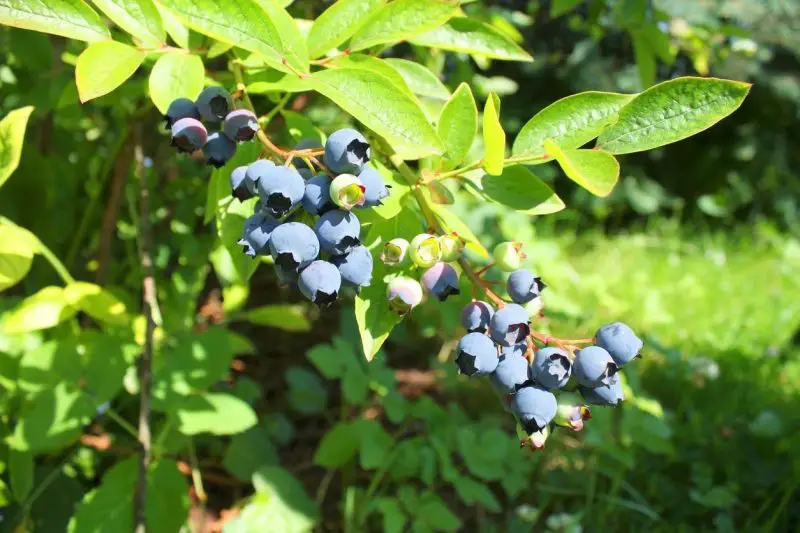
Vaccinium corymbosum, known as Highbush Blueberry, is a deciduous shrub cultivated for its delicious berries, ornamental foliage, and multi-season interest. Growing 6 to 12 feet tall, it features small, elliptical green leaves that turn vibrant red or orange in fall. In spring, bell-shaped white to pink flowers appear, followed by clusters of blue-purple berries in mid to late summer.
The plant is easily recognized by its edible fruit, which attracts birds and humans alike, and its fiery autumn foliage. Highbush Blueberry prefers acidic, well-drained soil and full sun for optimal fruiting. It thrives in USDA zones 3 to 7 and may require cross-pollination from another cultivar to produce abundant fruit.
This blueberry is widely used in edible landscaping, mixed borders, and wildlife gardens. It benefits from regular pruning, mulching, and irrigation during dry periods. In addition to providing nutritious fruit, it serves as a habitat plant and offers stunning color throughout the growing season.
Euonymus fortunei (Wintercreeper)
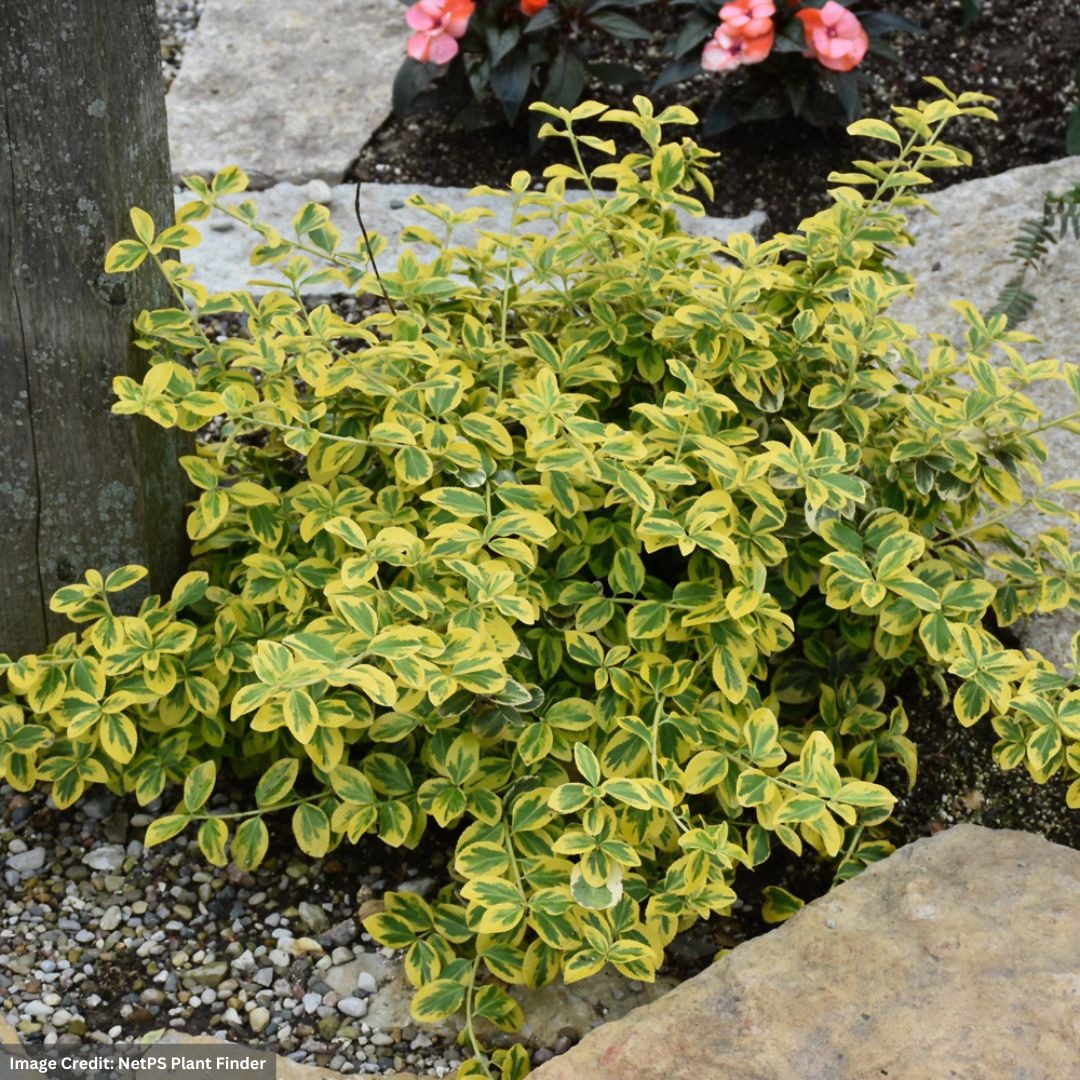
Euonymus fortunei, commonly known as Wintercreeper, is a versatile, evergreen shrub or groundcover that can also climb with support. It usually stays around 1 to 2 feet tall when used as groundcover but can climb up to 20 feet as a vine. It has glossy, dark green or variegated leaves depending on the cultivar, with small greenish-white flowers appearing in late spring.
This plant is notable for its dense, mat-forming growth and foliage that persists through winter. Wintercreeper thrives in a wide range of soils and light conditions, from full sun to full shade. It is hardy in USDA zones 5 to 9 and is highly adaptable to urban environments and difficult planting sites.
Wintercreeper is commonly used in groundcover applications, erosion control, and wall coverings. It is very low-maintenance but may require monitoring to prevent aggressive spreading. With its year-round foliage and ability to thrive in tough conditions, it is both functional and ornamental in a wide range of landscape designs.
Buxus sempervirens (Common Boxwood)
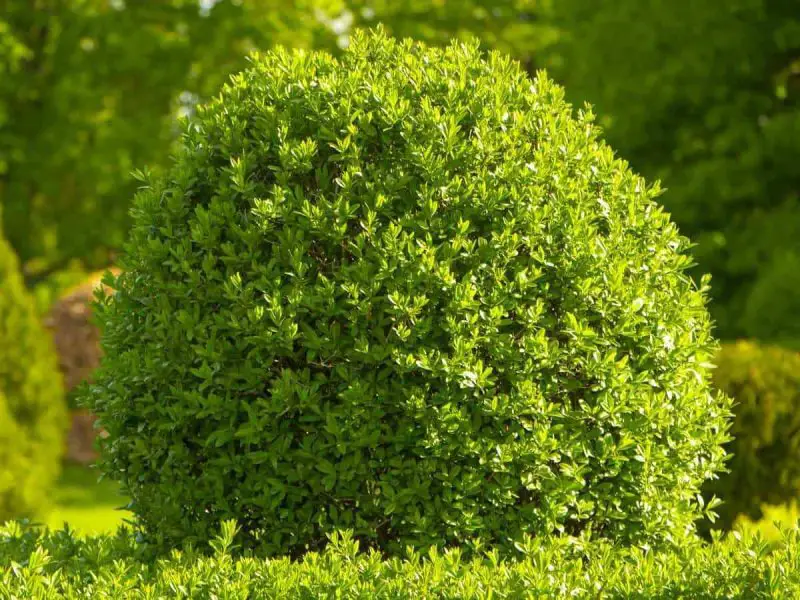
Buxus sempervirens, or Common Boxwood, is one of the most popular evergreen shrubs used in formal gardens and landscapes around the world. It grows slowly to form a dense, rounded shrub, typically reaching 5 to 15 feet in height if left unpruned. The small, leathery, dark green leaves stay vibrant year-round, and its fine texture makes it ideal for shaping.
This shrub is easily recognized for its tidy appearance and excellent tolerance for shearing and pruning, which makes it a staple for topiaries and hedges. Common Boxwood prefers well-drained soil and partial to full sun but can tolerate a range of conditions. It is hardy in USDA zones 5 to 8 and benefits from protection against harsh winter winds.
Widely used in foundation plantings, knot gardens, and borders, boxwood adds structure and elegance to both modern and traditional landscapes. Care involves regular pruning to maintain shape, mulching to protect roots, and attention to airflow to reduce risk of blight. Its evergreen nature and adaptability make it a timeless landscape choice.
Gaultheria procumbens (Wintergreen)
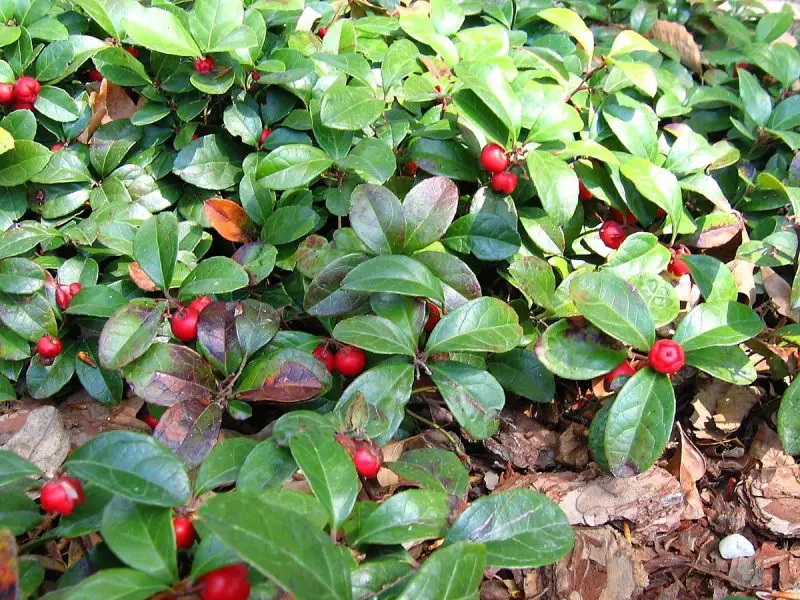
Gaultheria procumbens, commonly known as Wintergreen, is a low-growing, spreading evergreen shrub native to eastern North America. It typically grows just 4 to 6 inches tall and forms dense colonies. The shiny, dark green leaves emit a characteristic minty scent when crushed, and turn reddish in fall and winter. Small, bell-shaped white flowers bloom in summer, followed by bright red berries that persist through winter.
Wintergreen is easily identified by its aromatic leaves and showy berries. It prefers acidic, well-drained, humus-rich soil and grows best in part shade to full shade. This plant is hardy in USDA zones 3 to 8 and thrives in woodland gardens and shady borders.
Used mainly as a groundcover in shaded or woodland settings, Wintergreen provides four-season interest and attracts birds with its berries. It requires minimal care, aside from occasional watering in dry spells. Its low height, fragrance, and colorful winter display make it an attractive addition to naturalistic gardens.
Picea glauca ‘Conica’ (Dwarf White Spruce)
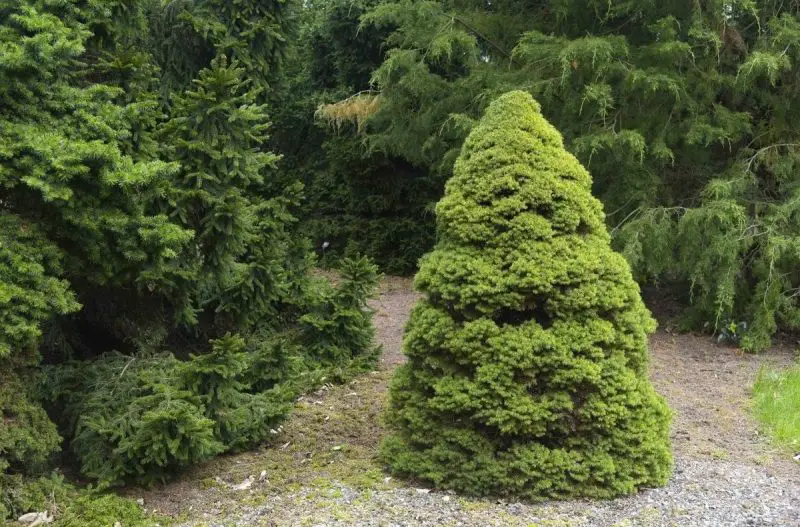
Picea glauca ‘Conica’, or Dwarf White Spruce, is a slow-growing, conical evergreen shrub known for its symmetrical shape and fine-textured, blue-green needles. It typically reaches 4 to 6 feet tall in 10 years, making it ideal for small gardens or container plantings. Its dense foliage provides a neat and tidy look year-round.
This compact spruce is recognized for its miniature Christmas-tree form and its soft, new growth in spring. It thrives in moist, well-drained soil and full sun, though it benefits from some afternoon shade in hot climates. It is hardy in USDA zones 2 to 6 and requires protection from drying winter winds and extreme heat.
Dwarf White Spruce is often used as an accent in rock gardens, entryways, and formal plantings. Minimal pruning is needed to maintain its shape, and occasional watering helps it through dry periods. Its elegant form and cold-hardiness make it a charming and reliable landscape plant.
Kalmia latifolia (Mountain Laurel)
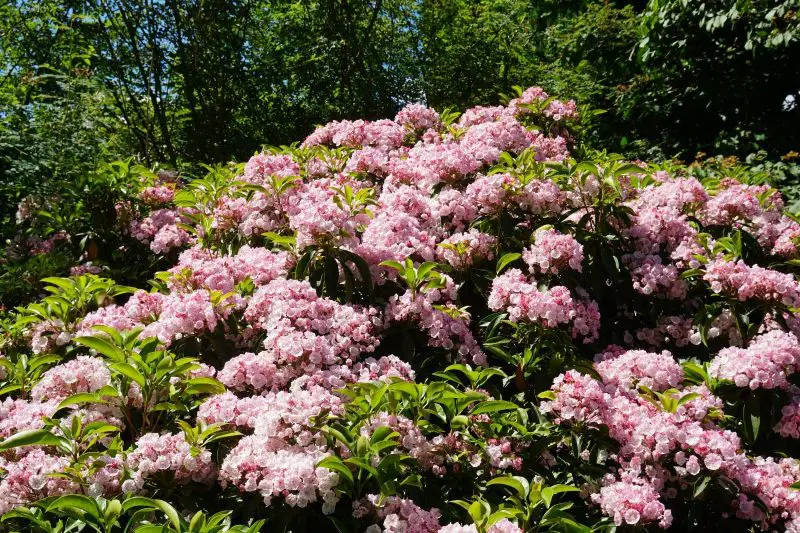
Kalmia latifolia, known as Mountain Laurel, is a beautiful, broadleaf evergreen shrub native to the eastern United States. It grows between 5 and 15 feet tall and features leathery, glossy green leaves. In late spring to early summer, it produces large clusters of intricate, cup-shaped flowers ranging in color from white to deep pink with darker markings.
This shrub is noted for its spectacular floral display and attractive evergreen foliage. Mountain Laurel prefers acidic, moist but well-drained soil and partial shade, though it can tolerate full sun in cooler climates. It is hardy in USDA zones 4 to 9 and performs well in woodland and shaded garden settings.
Mountain Laurel is used in foundation plantings, mixed shrub borders, and native gardens for its aesthetic appeal. While it requires some maintenance to remove spent flowers and manage shape, it is generally easy to care for. Its bold blooms and evergreen structure make it a show-stopping addition to landscapes.
Juniperus horizontalis (Creeping Juniper)
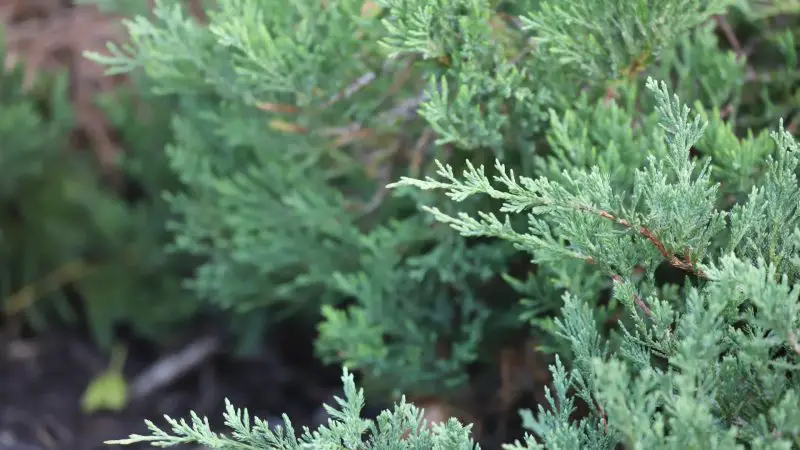
Juniperus horizontalis, or Creeping Juniper, is a low-growing, mat-forming evergreen shrub native to North America. It typically spreads 6 to 10 feet wide while remaining under 1 foot tall. The scale-like, silvery-blue to green foliage provides excellent year-round groundcover, and some cultivars exhibit attractive purple tones in winter.
This plant is identified by its prostrate habit and evergreen foliage that hugs the ground. Creeping Juniper thrives in full sun and well-drained soils, tolerating drought, wind, and poor soil conditions. It is hardy in USDA zones 3 to 9, making it a versatile option for a wide range of climates.
Used widely for erosion control, rock gardens, and sloped areas, this juniper offers a low-maintenance alternative to turf. It requires little pruning and minimal watering once established. Its rugged resilience and spreading form make it ideal for both decorative and functional landscaping needs.
Small Evergreen Shrubs in Europe
Buxus sempervirens ‘Suffruticosa’ (Dwarf Boxwood)
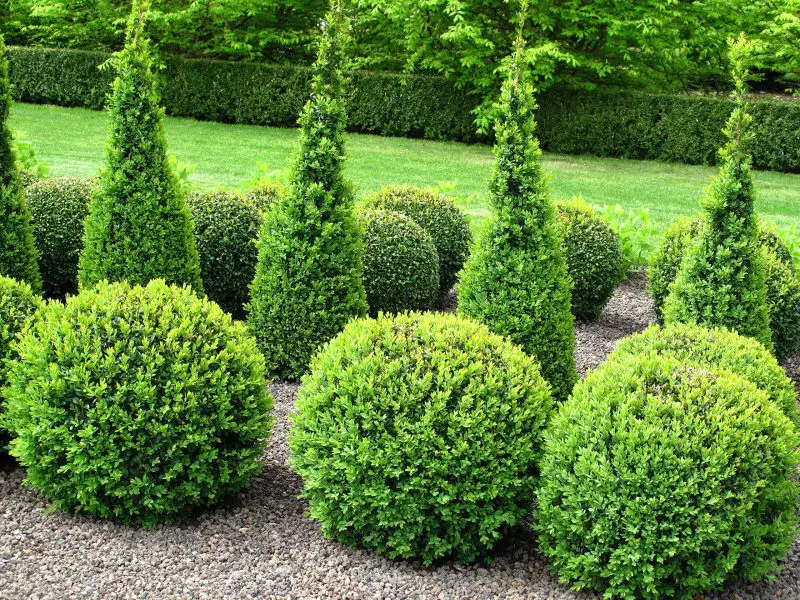
Buxus sempervirens ‘Suffruticosa’, commonly known as Dwarf Boxwood, is a compact, slow-growing evergreen shrub often used in formal gardens and borders. It grows to about 2 to 3 feet in both height and width, with a naturally rounded shape and tiny, glossy green leaves that persist year-round. Its dense habit and diminutive size make it ideal for creating low hedges and topiary designs.
This boxwood is best identified by its fine-textured foliage and small stature. It prefers well-drained soils and can thrive in both full sun and partial shade. Dwarf Boxwood is hardy in USDA zones 5 to 8 and benefits from some winter protection against wind and temperature fluctuations.
Widely used in edging, knot gardens, and as a neat low-growing accent, this shrub adds a refined, evergreen presence to landscapes. It requires regular trimming to maintain its shape and airflow to prevent disease. Its classic appeal and versatility make it a favorite among gardeners looking for structure and elegance in limited spaces.
Pernettya mucronata (Cranberry Heath)
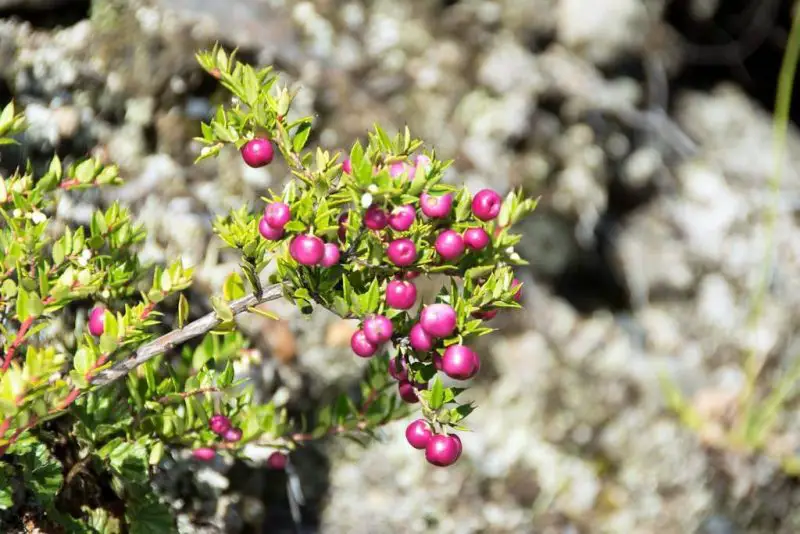
Pernettya mucronata, also known as Cranberry Heath or prickly heath, is a compact evergreen shrub prized for its vibrant berries and glossy green foliage. It typically grows 2 to 4 feet tall and wide, forming a rounded mound. The small, white or pink bell-shaped flowers appear in spring and are followed by showy red, purple, or white berries in the fall that persist into winter.
Cranberry Heath is easily recognized by its striking berries and stiff, pointed leaves. It thrives in acidic, well-drained soils and prefers full sun to partial shade. This plant is hardy in USDA zones 6 to 9 and performs well in cool, moist climates. Male and female plants are required for berry production.
It is commonly used in borders, rock gardens, or as a groundcover in acidic garden beds. The plant needs minimal pruning and should be protected from excessive heat and drought. With its year-round interest and ornamental berries, Pernettya mucronata is an excellent choice for adding color to woodland gardens and shady corners.
Hebe ‘Mrs. W. F. Gillanders’ (Gillanders Hebe)
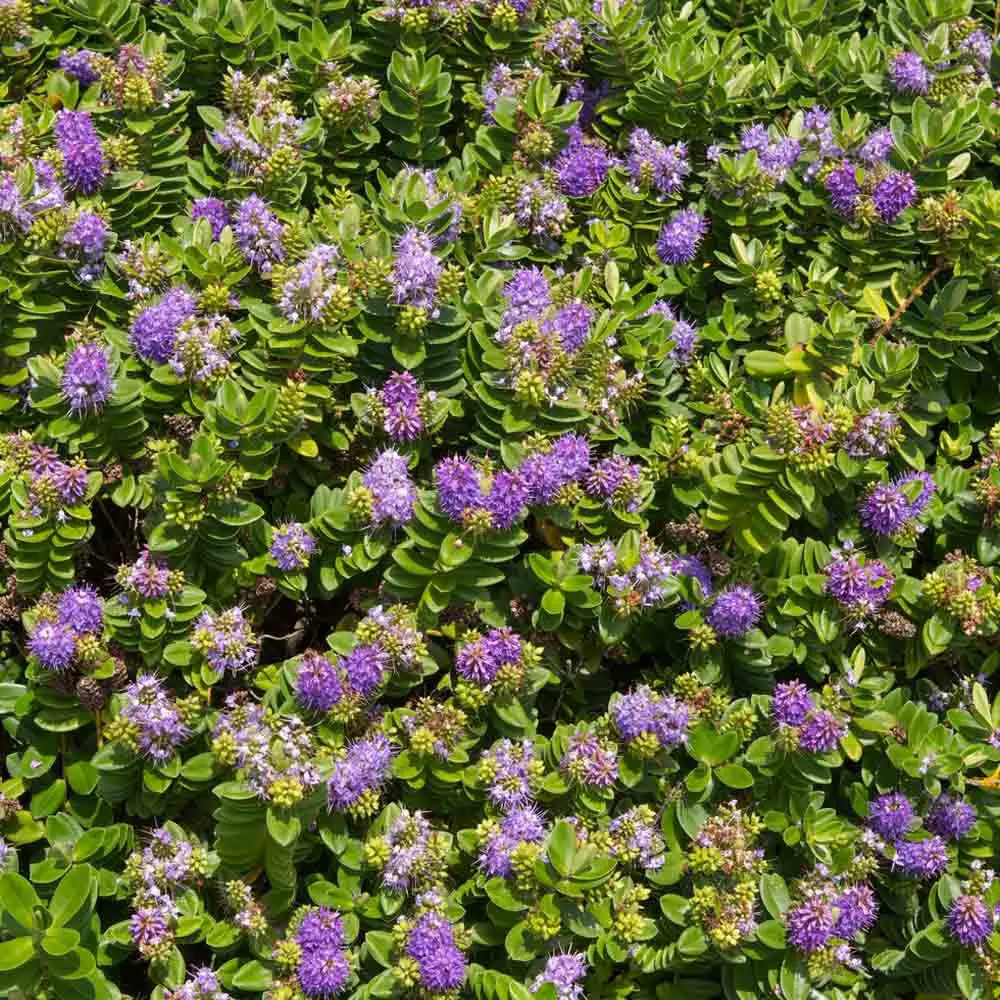
Hebe ‘Mrs. W. F. Gillanders’ is a compact, evergreen shrub known for its lush, glossy green foliage and vibrant floral display. It typically reaches 2 to 3 feet in height and width, forming a rounded, bushy shape. In mid to late summer, it produces spikes of rich violet or purple flowers that attract pollinators.
This hebe variety stands out due to its attractive leaves and long-lasting blooms. It prefers well-drained soils and full sun to light shade and is best suited for mild coastal climates. Gillanders Hebe is hardy in USDA zones 7 to 9 and benefits from protection in colder or exposed locations.
Ideal for mixed borders, patio containers, and coastal gardens, this plant offers vibrant summer color and evergreen structure. Light pruning after flowering maintains its shape and vigor. Its ornamental value and compact form make it a popular choice for adding a splash of color and texture to small gardens.
Daphne cneorum (Garland Daphne)
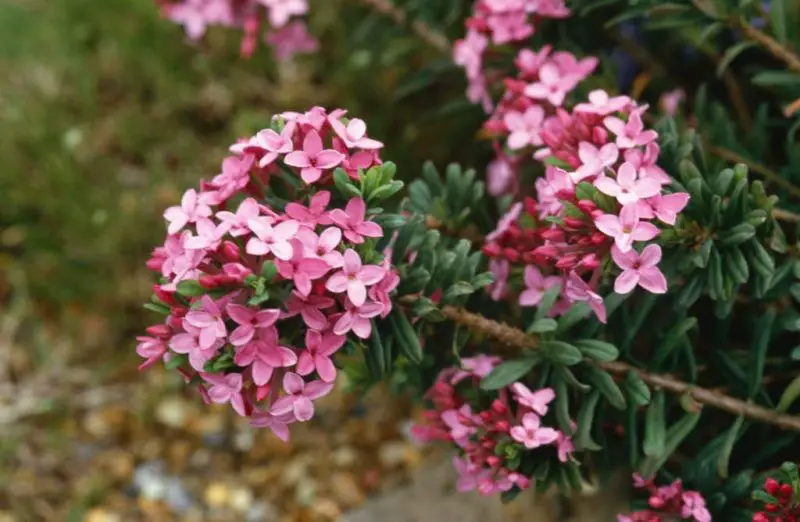
Daphne cneorum, commonly called Garland Daphne, is a low-growing, evergreen shrub with an elegant, spreading habit. It typically grows 6 to 12 inches high and spreads up to 3 feet wide. This plant is especially valued for its intensely fragrant, pink to deep rose flowers that bloom in spring and sometimes rebloom in early summer.
Easily recognized by its aromatic blooms and trailing branches, Garland Daphne prefers alkaline to neutral, well-drained soils and full sun to partial shade. It is hardy in USDA zones 4 to 8 and thrives in rock gardens, slopes, or alpine beds where drainage is excellent.
Daphne cneorum is used in borders, raised beds, and fragrant gardens where its scent can be appreciated. It requires little maintenance beyond ensuring proper soil drainage. Due to its sensitivity to root disturbance, it is best planted in a permanent location. Its delicate appearance and sweet fragrance make it a treasured addition to specialty garden spaces.
Prunus laurocerasus ‘Otto Luyken’ (Otto Luyken Cherry Laurel)
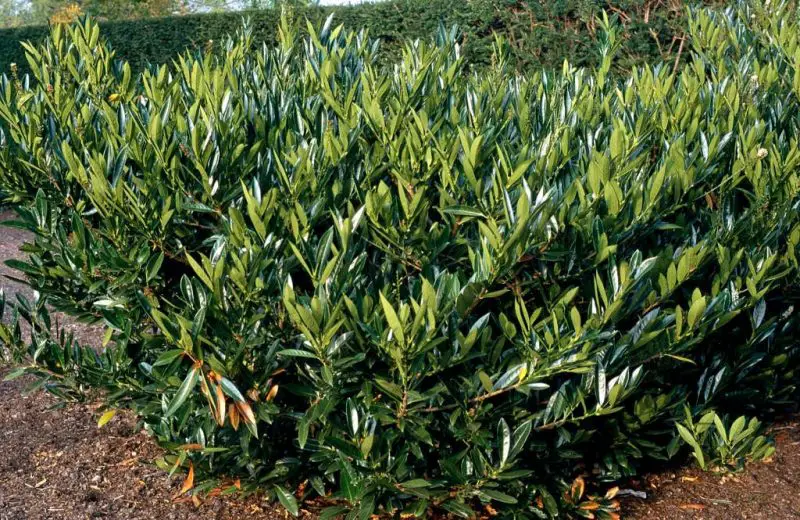
Prunus laurocerasus ‘Otto Luyken’ is a compact cultivar of the Cherry Laurel, forming a dense, rounded evergreen shrub. It typically grows 3 to 4 feet tall and spreads 6 to 8 feet wide. The narrow, leathery dark green leaves create a glossy backdrop for its upright spikes of fragrant white flowers in spring, which are often followed by small black berries.
This shrub is known for its compact growth habit and attractive foliage. It prefers moist, well-drained soil and can tolerate both full sun and shade, making it highly versatile. Otto Luyken is hardy in USDA zones 6 to 9 and adapts well to urban conditions, pollution, and pruning.
Often used for foundation plantings, hedges, and privacy screens, Otto Luyken Cherry Laurel provides year-round greenery with minimal maintenance. Regular pruning helps maintain shape and encourage new growth. Its hardiness, ease of care, and neat form make it a reliable and stylish choice for formal or informal landscapes.
Viburnum tinus (Laurustinus)
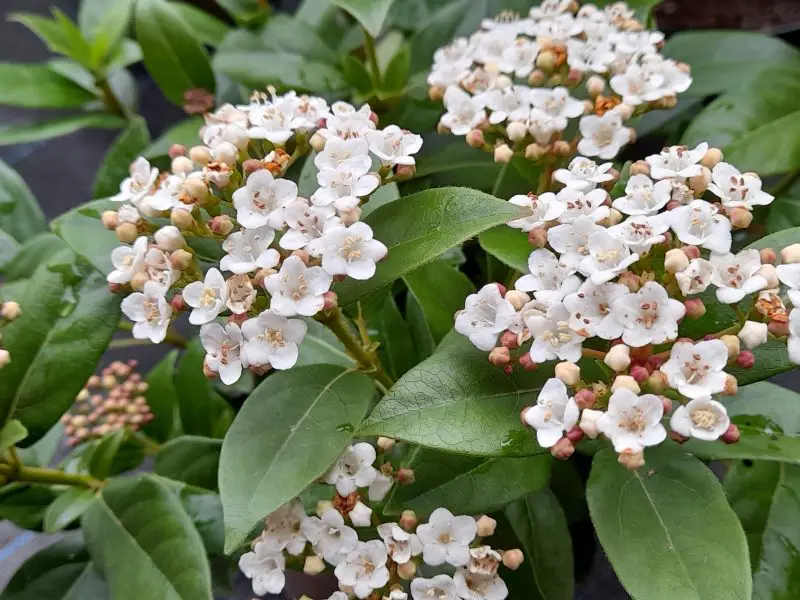
Viburnum tinus, commonly known as Laurustinus, is a dense, evergreen shrub native to the Mediterranean region. It typically grows 6 to 12 feet tall and wide, forming a rounded shape with leathery, dark green leaves. Clusters of small, fragrant white to pale pink flowers appear from late winter through early spring, followed by metallic blue-black berries that attract birds.
This shrub is easily identified by its lush foliage and long blooming season. It prefers well-drained soil and thrives in full sun to partial shade. Viburnum tinus is hardy in USDA zones 8 to 10, making it well-suited for coastal and southern climates. It tolerates wind, salt spray, and light frost, making it ideal for exposed locations.
Often used in hedges, privacy screens, and foundation plantings, Laurustinus provides year-round interest with its foliage, flowers, and fruit. Prune after flowering to shape and encourage dense growth. Its adaptability and ornamental qualities make it a popular choice for both formal and naturalistic landscapes.
Euonymus japonicus ‘Microphyllus’ (Japanese Spindle Tree)
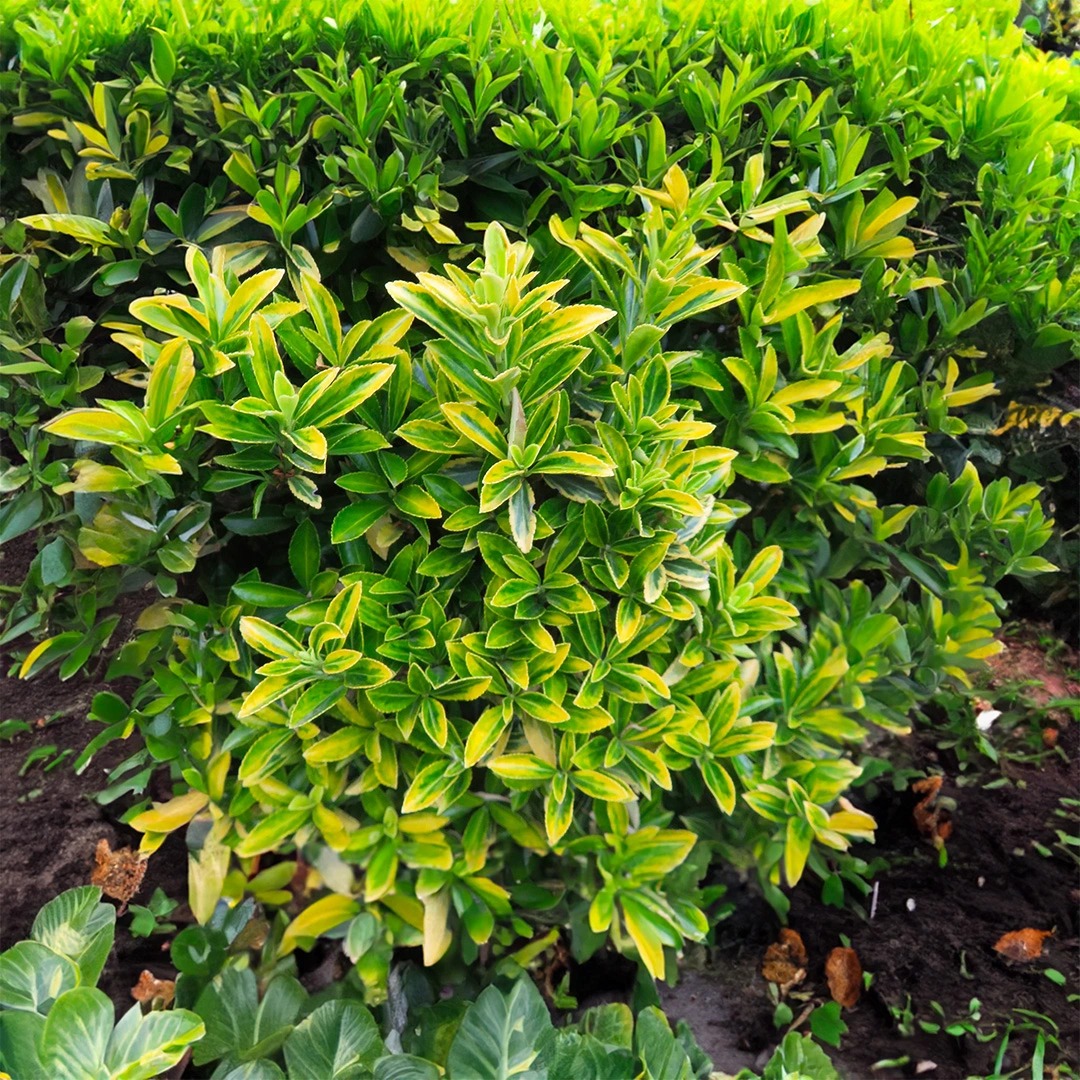
Euonymus japonicus ‘Microphyllus’, or Japanese Spindle Tree, is a compact, slow-growing evergreen shrub prized for its tiny, glossy green leaves. Typically reaching 1 to 2 feet in height and width, it forms a tidy, mound-like shape that makes it ideal for low borders and edging. Its foliage remains vibrant throughout the year, offering subtle texture and structure.
This cultivar is known for its finely textured leaves and neat growth habit. It thrives in well-drained soil and full sun to partial shade. Hardy in USDA zones 6 to 9, it is tolerant of heat, drought, and urban pollution. It can also be clipped into small topiaries or used in bonsai applications due to its dense form.
Japanese Spindle Tree ‘Microphyllus’ is commonly used in rock gardens, low hedges, and container plantings. Light pruning in early spring helps maintain its compact form. With minimal care requirements and year-round appeal, it’s a dependable choice for formal and small-scale landscapes.
Sarcococca confusa (Sweet Box)
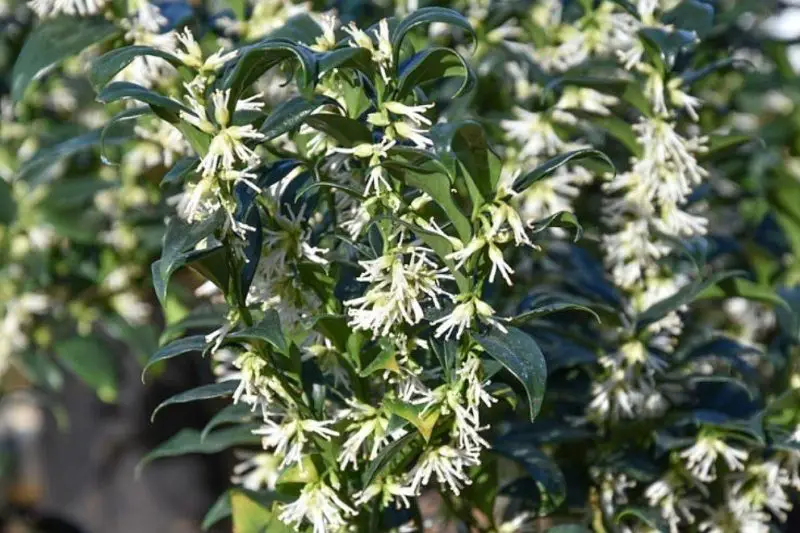
Sarcococca confusa, known as Sweet Box, is a shade-loving evergreen shrub with a slow-growing, upright habit. It typically reaches 3 to 5 feet tall and slightly narrower in width. Its glossy, dark green leaves create a rich backdrop for the small, creamy white flowers that bloom in late winter and early spring, releasing a powerful, sweet fragrance. These are followed by shiny black berries.
This plant is easily recognized by its fragrant blooms and tolerance for deep shade. It thrives in moist, well-drained soil and prefers a sheltered location. Sweet Box is hardy in USDA zones 7 to 9 and performs well in woodland gardens or north-facing sites.
Used as a groundcover or in mass plantings beneath trees, Sarcococca confusa adds scent and evergreen interest during the bleak winter months. It requires minimal pruning and is drought-tolerant once established. Its ability to brighten shady spaces with fragrance and foliage makes it a hidden gem in many garden designs.
Rhododendron x impeditum (Impeding Rhododendron)
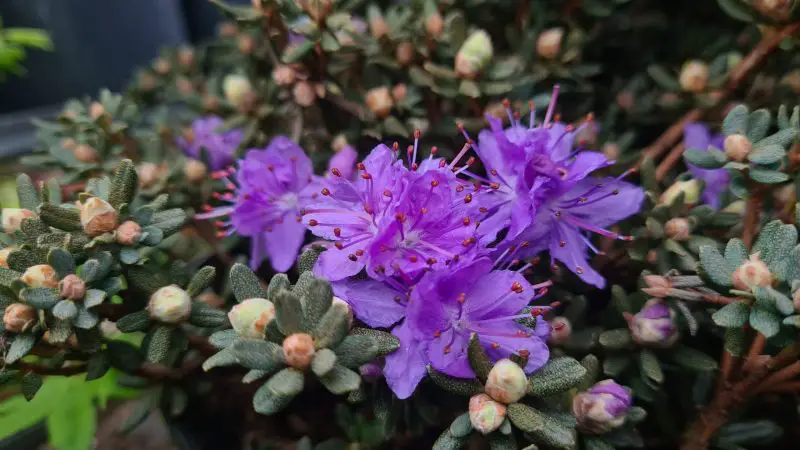
Rhododendron x impeditum, or Impeding Rhododendron, is a dwarf evergreen shrub ideal for rock gardens and compact spaces. It typically grows 1 to 2 feet tall and slightly wider, forming a dense, mounded shape. Its small, aromatic leaves have a bluish-green hue, and the plant is adorned with vivid purple or violet flowers in mid to late spring.
This rhododendron is noted for its compact size and profuse blooms. It prefers acidic, well-drained soils rich in organic matter and thrives in partial shade to dappled sunlight. Hardy in USDA zones 5 to 8, it is particularly suitable for cooler climates with consistent moisture.
Impeding Rhododendron is a favorite in alpine gardens, small borders, and container displays. It needs protection from harsh afternoon sun and drying winds. With minimal pruning and careful placement, it offers vibrant color and evergreen charm in even the smallest garden spaces.
Juniperus communis ‘Compressa’ (Dwarf Common Juniper)
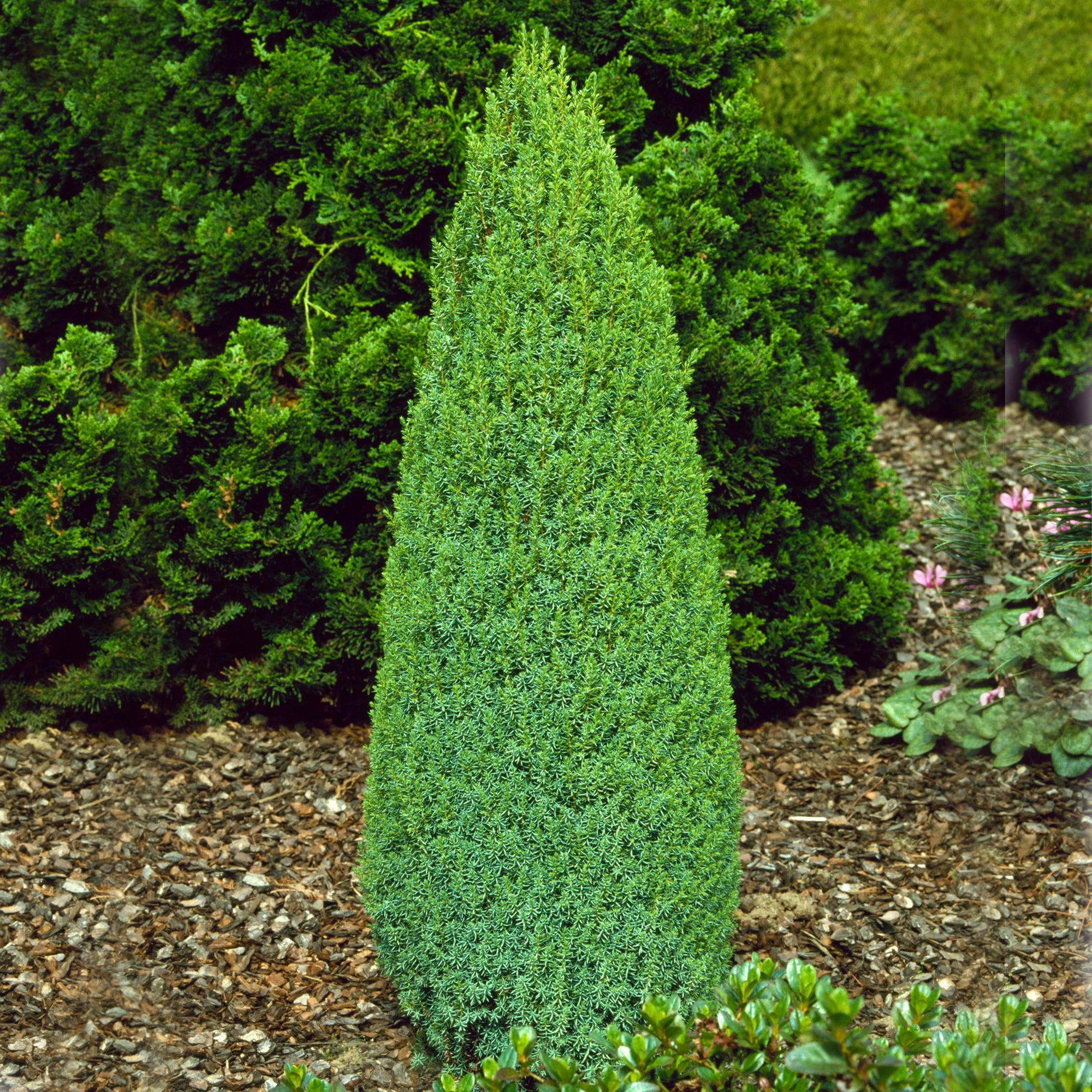
Juniperus communis ‘Compressa’, or Dwarf Common Juniper, is a narrow, columnar evergreen shrub known for its tight, upright habit. Growing slowly to about 2 to 3 feet tall and only 1 foot wide, it features dense, blue-green needle-like foliage that gives it a sculptural quality throughout the year.
This juniper is easily identified by its narrow, spire-like shape and compact growth. It thrives in well-drained soils and full sun and is hardy in USDA zones 2 to 6, making it suitable for cold northern climates. It is drought-tolerant once established and requires little maintenance.
Ideal for rock gardens, troughs, and formal settings, ‘Compressa’ is often used as a vertical accent or in small-scale topiary. Pruning is rarely needed due to its slow growth and natural form. Its striking appearance and cold-hardiness make it a standout choice for structure and texture in the landscape.
Small Evergreen Shrubs in Australia
Correa reflexa (Red Correa)
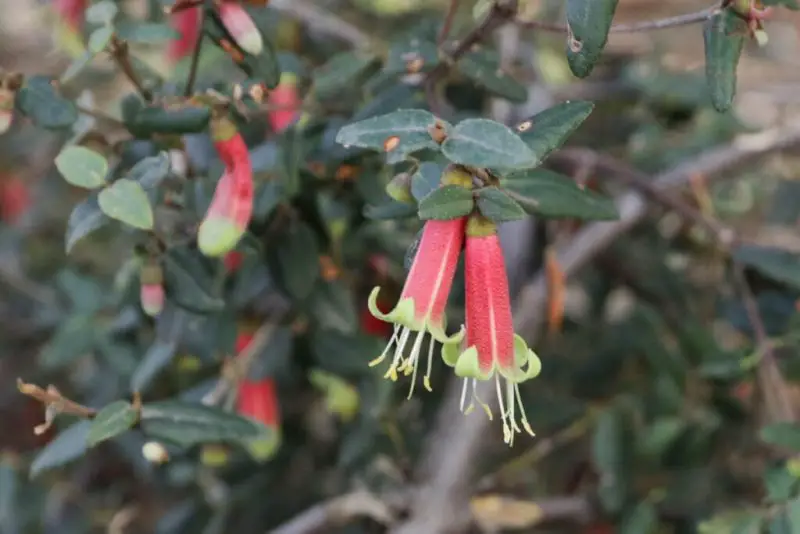
Correa reflexa, commonly known as Red Correa or Native Fuchsia, is a small evergreen shrub native to southeastern Australia. It typically grows between 3 to 6 feet tall and wide, featuring arching branches with rounded, leathery green leaves. Its bell-shaped, red to pink flowers with green tips bloom from autumn through spring, attracting nectar-feeding birds and insects.
This plant is recognizable for its tubular, pendant flowers and compact, mounding form. It prefers well-drained soil and partial shade, though it can tolerate full sun in cooler climates. Red Correa is hardy in USDA zones 8 to 10 and is drought-tolerant once established. It performs well in coastal gardens and sheltered woodland settings.
Correa reflexa is valued in landscape design for its extended flowering season, wildlife support, and adaptability. It makes a fine specimen plant, low hedge, or understorey addition in native and informal gardens. Occasional pruning after flowering helps maintain its shape and encourages bushier growth.
Grevillea ‘Coastal Gem’ (Coastal Gem Grevillea)
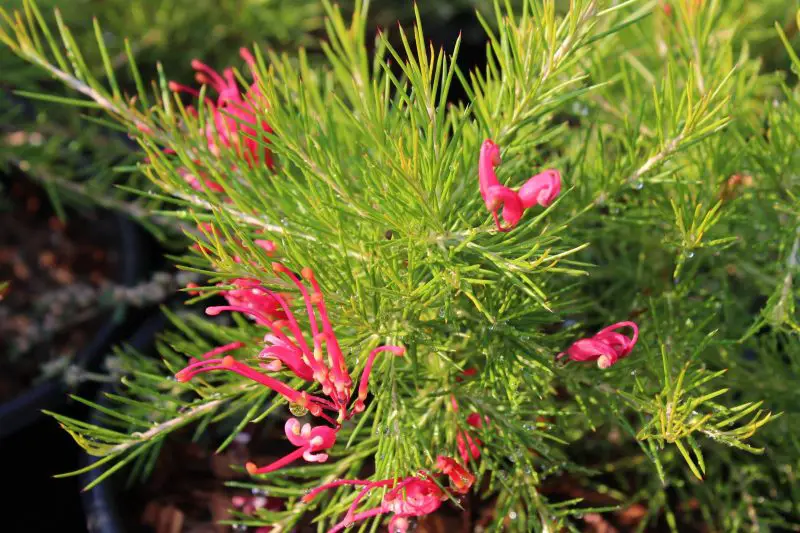
Grevillea ‘Coastal Gem’ is a low-growing hybrid evergreen shrub developed in Australia, known for its dense, mat-forming habit and fine, silvery foliage. It typically reaches 1 to 2 feet in height with a spread of up to 4 feet, making it ideal as a groundcover. Clusters of pinkish-red, spider-like flowers appear throughout the year, especially during spring and summer.
The plant thrives in full sun and well-drained soils, tolerating drought, salt spray, and poor soils once established. It is best suited to USDA zones 9 to 11 and performs well in warm, coastal environments. Its compact nature and low water needs make it highly versatile in xeriscaping and coastal landscapes.
Grevillea ‘Coastal Gem’ is often used to stabilize slopes, line pathways, or provide low-maintenance greenery in dry gardens. It attracts birds and pollinators and benefits from occasional light pruning to keep its form tidy. Avoid phosphorus-rich fertilizers, which can be harmful to grevilleas.
Leptospermum scoparium (Manuka)
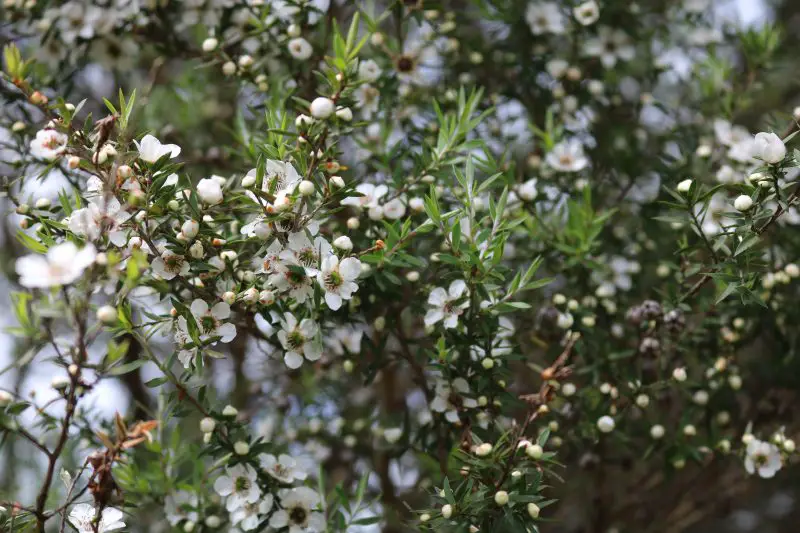
Leptospermum scoparium, commonly called Manuka or Tea Tree, is a hardy evergreen shrub native to New Zealand and southeastern Australia. It grows 6 to 10 feet tall, featuring small, aromatic leaves and rough, dark bark. The plant produces masses of white, pink, or red five-petaled flowers from spring through summer, often attracting bees for honey production.
Manuka thrives in well-drained soils and full sun to partial shade. It is hardy in USDA zones 9 to 11 and tolerates coastal winds, drought, and poor soils. While moderately frost-tolerant, it benefits from some protection in cooler regions. Pruning after flowering helps maintain its shape and encourages new blooms.
In landscaping, Manuka is admired for its floral display and resilience. It works well as a hedge, specimen plant, or feature in native gardens. Its flowers support pollinators, and the plant’s medicinal and antimicrobial properties give it added value beyond aesthetics.
Callistemon citrinus (Crimson Bottlebrush)

Callistemon citrinus, known as the Crimson Bottlebrush, is a striking evergreen shrub native to eastern Australia. It grows 6 to 12 feet tall and wide, with narrow, aromatic leaves that release a citrus scent when crushed. The most distinctive feature is its bright red, brush-like flower spikes that appear from spring through summer and sometimes in fall.
This shrub thrives in full sun and well-drained soils and is tolerant of drought, heat, and coastal conditions. Hardy in USDA zones 8 to 11, it can withstand light frost and adapts well to a variety of soils, including clay and sandy types. Its deep root system makes it resilient during dry spells.
Callistemon citrinus is a favorite for attracting hummingbirds, bees, and butterflies. It’s used in borders, screens, or as a specimen plant in both formal and informal gardens. Regular pruning after flowering maintains its compact form and promotes more blooms. It also adapts well to container cultivation in warmer climates.
Banksia ericifolia (Heath-leaved Banksia)
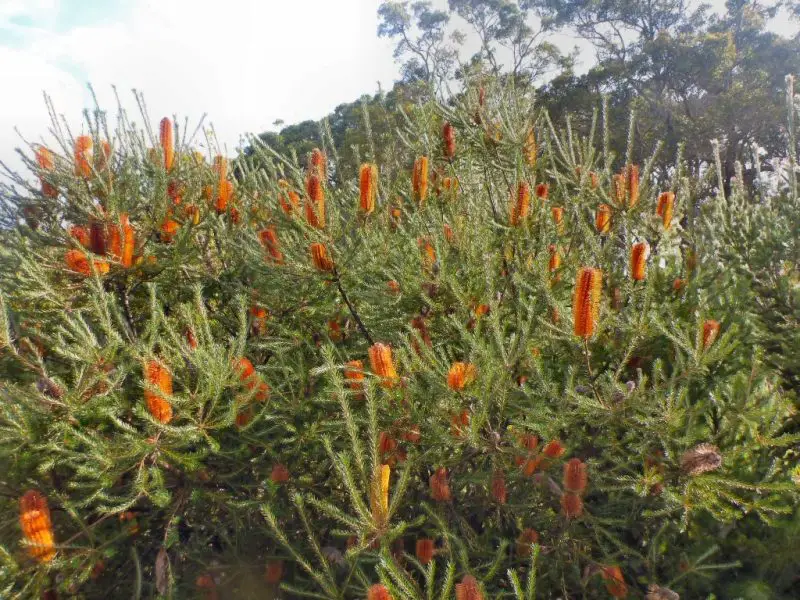
Banksia ericifolia, or Heath-leaved Banksia, is a tall, narrow evergreen shrub endemic to eastern Australia. It typically grows between 6 to 20 feet tall, depending on the cultivar, with fine, needle-like foliage. Its cylindrical, orange to red flower spikes appear from fall through spring and are rich in nectar, making them highly attractive to birds and insects.
This shrub prefers full sun and sandy, well-drained soils and is highly drought- and fire-tolerant. It is hardy in USDA zones 9 to 11 and is best suited to warm, dry climates. It does not tolerate heavy clay or overly wet soils. Minimal pruning is needed, though light shaping after flowering helps maintain a neat habit.
In landscaping, Banksia ericifolia is prized for its architectural form, vibrant flowers, and ecological value. It works well in coastal gardens, native plantings, or as a dramatic specimen. Its tolerance of poor soils and dry conditions makes it a dependable and sustainable choice for challenging sites.
Small Evergreen Shrubs in Asia
Azalea japonica (Japanese Azalea)
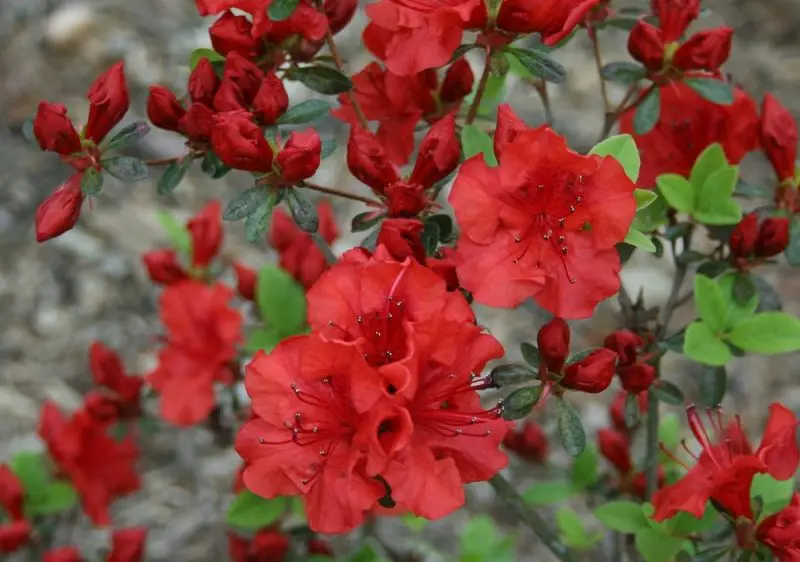
Azalea japonica, or Japanese Azalea, is a compact evergreen shrub widely cherished for its vibrant spring blooms and dense foliage. Typically reaching 2 to 4 feet in height and spread, it features small, leathery green leaves that may take on bronze or reddish hues in winter. In mid to late spring, it bursts into a stunning display of funnel-shaped flowers in shades of pink, red, purple, or white.
Native to Japan, this azalea prefers acidic, well-drained soil and partial shade, though it can tolerate full sun in cooler climates. It is hardy in USDA zones 6 to 9 and benefits from consistent moisture, especially during the growing season. Light pruning after flowering helps maintain a neat form and encourages branching.
Japanese Azalea is ideal for borders, foundation plantings, and woodland gardens. Its compact size and slow growth make it suitable for containers or bonsai as well. With minimal care, it brings year-round greenery and a burst of seasonal color to shaded garden areas.
Pieris japonica (Japanese Pieris)
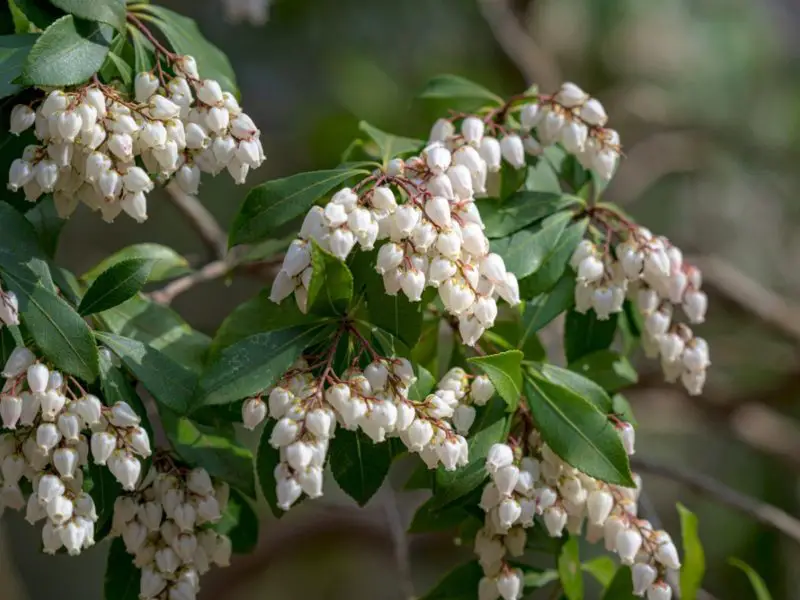
Pieris japonica, also known as Japanese Pieris or Andromeda, is an elegant evergreen shrub native to eastern Asia. It typically grows 6 to 10 feet tall and features cascading clusters of bell-shaped white or pink flowers that bloom in early spring. New foliage often emerges in shades of bronze or red, adding visual interest throughout the year.
This shrub thrives in acidic, moist, well-drained soil and partial shade, making it a good companion for rhododendrons and camellias. Hardy in USDA zones 5 to 8, it prefers sheltered locations protected from harsh winter winds and hot afternoon sun. Mulching helps retain soil moisture and keep roots cool.
Japanese Pieris is often used in foundation plantings, shaded borders, and woodland gardens. Its refined form and multi-season appeal make it a valuable specimen plant. It requires minimal pruning and is relatively pest-resistant, although it benefits from occasional feeding with an acid-loving plant fertilizer.
Skimmia japonica (Japanese Skimmia)
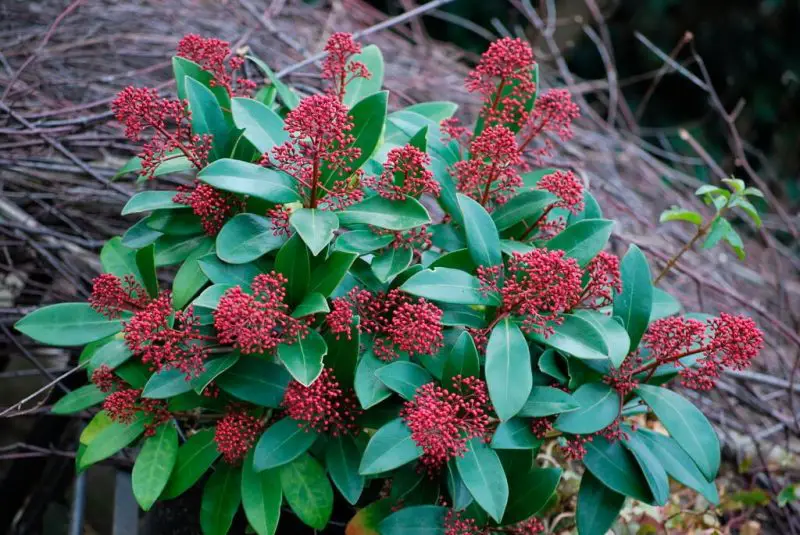
Skimmia japonica is a tidy evergreen shrub with dense, glossy foliage and fragrant flowers, native to Japan and parts of China. This rounded shrub typically grows 3 to 4 feet tall and wide. In spring, it produces clusters of small, star-shaped white or creamy flowers, often followed by red berries on female plants if a male plant is nearby for pollination.
Thriving in USDA zones 6 to 8, Skimmia prefers moist, well-drained, acidic soils and performs best in part to full shade. It tolerates urban pollution and is well-suited to container growing or shady garden beds. Protection from harsh sun prevents leaf scorch and maintains vibrant foliage.
Japanese Skimmia is widely used in foundation plantings, shaded borders, and woodland landscapes. Its year-round foliage, seasonal blooms, and berries provide four-season interest. It’s also deer-resistant and low maintenance, making it a favored choice for shaded, low-light garden areas.
Elaeagnus pungens (Gleaming Oleaster)

Elaeagnus pungens, known as Gleaming Oleaster or Silverthorn, is a vigorous evergreen shrub known for its dense growth and silvery-green foliage. It typically reaches 8 to 12 feet tall and wide, with thorny branches and leathery leaves that have silvery undersides. Tiny, fragrant white flowers bloom in late fall and are followed by small, edible fruits.
This adaptable shrub tolerates a wide range of soil types, including poor and sandy soils, and is drought- and salt-tolerant once established. It thrives in USDA zones 7 to 9 and prefers full sun to partial shade. Its fast growth and resilience make it ideal for hedging or screening in challenging environments.
Gleaming Oleaster is frequently used for erosion control, windbreaks, and privacy screens. Its ability to grow in tough conditions and resist deer and pests makes it a reliable choice for low-maintenance landscapes. Occasional pruning helps maintain its shape and size.
Corylus avellana (Common Hazel)
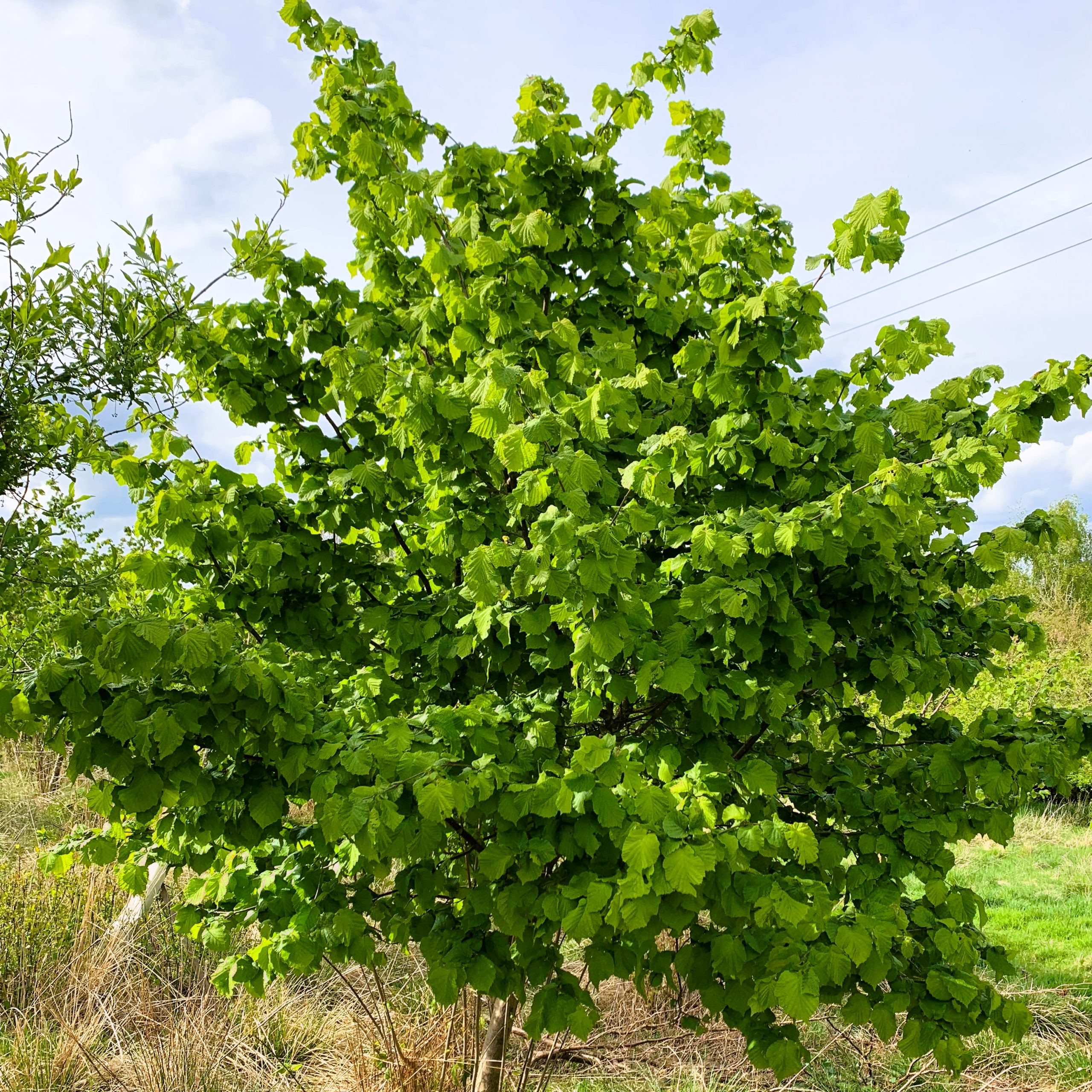
Corylus avellana, or Common Hazel, is a deciduous shrub or small tree native to Europe and parts of western Asia. It can reach up to 12 to 20 feet in height and spread, with broad, rounded leaves and smooth gray bark. In late winter to early spring, it produces long yellow catkins (male flowers) and tiny red female flowers, followed by edible hazelnuts in late summer.
Although not evergreen, it maintains dense branching and structure through winter, offering seasonal interest. It grows best in full sun to partial shade and moist, well-drained soil. Hardy in USDA zones 4 to 8, it’s relatively easy to grow and tolerates pruning well.
Common Hazel is valued in both ornamental and productive gardens. It’s used in hedgerows, wildlife habitats, and nut orchards. The shrub provides food for pollinators and birds, and its nuts are harvested for human consumption. It can be coppiced to encourage bushier growth or used in naturalistic plantings.
Berberis thunbergii (Japanese Barberry)
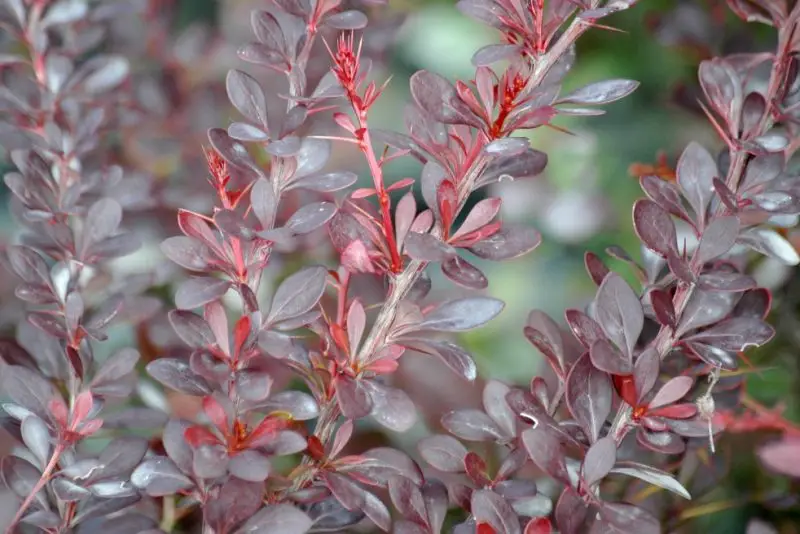
Berberis thunbergii, commonly known as Japanese Barberry, is a compact deciduous shrub often used for its colorful foliage and thorny branches. Although not evergreen in colder climates, some cultivars retain their leaves longer in mild regions, giving them year-round presence. It typically grows 3 to 6 feet tall and wide, with small, oval leaves in shades ranging from green to deep red or golden yellow.
Native to Japan, this species thrives in full sun to partial shade and prefers well-drained soil. It is hardy in USDA zones 4 to 8 and is drought-tolerant once established. Tiny yellow flowers appear in spring, followed by red berries in fall that persist into winter, adding ornamental value and attracting birds.
Japanese Barberry is frequently used in hedges, borders, and foundation plantings. Its dense, spiny branches make it effective for barrier plantings. Though attractive, it is considered invasive in some parts of North America, so check local guidelines before planting. Prune regularly to maintain shape and prevent spread.
Osmanthus delavayi (Delavay Osmanthus)
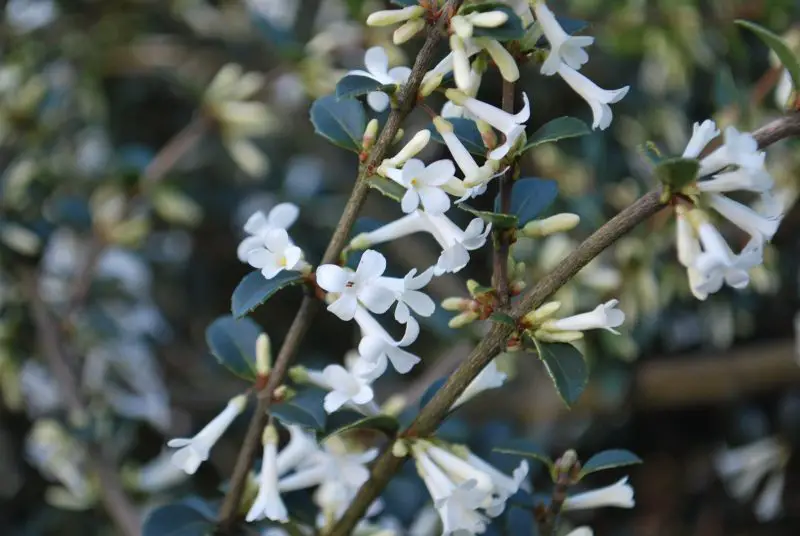
Osmanthus delavayi, or Delavay Osmanthus, is an elegant broadleaf evergreen shrub prized for its fragrant white flowers and dense, dark green foliage. It grows slowly, forming a rounded shape of about 6 to 10 feet tall and wide. The finely serrated, glossy leaves provide a tidy appearance year-round, making it excellent for formal gardens.
Native to China, this shrub thrives in USDA zones 7 to 9, preferring moist, well-drained soil and partial to full sun. In early spring, it produces clusters of tiny, tubular white flowers with a sweet jasmine-like fragrance. Though relatively slow-growing, it is long-lived and low maintenance.
Delavay Osmanthus is ideal for hedges, screens, or as a standalone specimen. Its dense growth habit and evergreen foliage offer structure to the garden through all seasons. Light pruning after flowering encourages a neat form, and the plant tolerates some drought once established.
Mahonia aquifolium (Oregon Grape Holly)
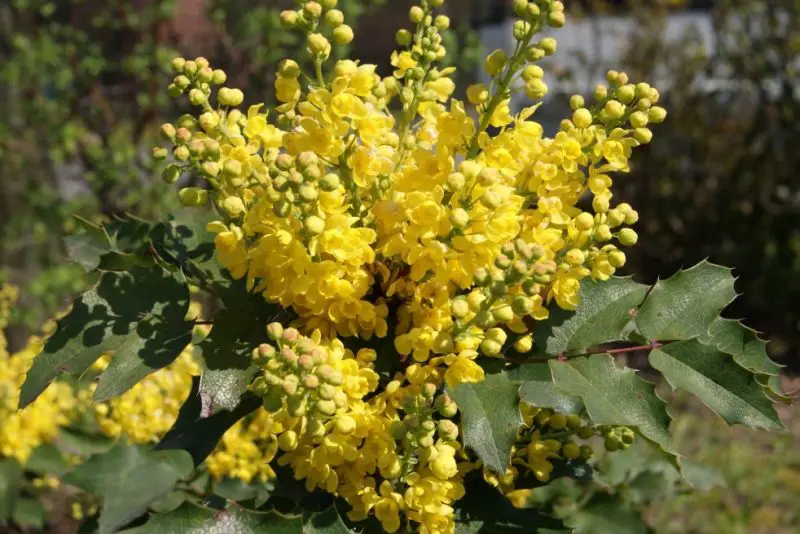
Mahonia aquifolium, known as Oregon Grape Holly, is a striking evergreen shrub featuring holly-like leaves, fragrant yellow flowers, and bluish-black berries. It grows 3 to 6 feet tall and wide, with spiny, leathery leaves that often turn purple or bronze in winter. Its cheerful yellow flower clusters bloom in early spring.
Native to western North America, this shrub thrives in USDA zones 5 to 9 and prefers partial shade and moist, well-drained soil. However, it is adaptable to drier conditions and various soil types. After flowering, grape-like berries develop, attracting birds and wildlife.
Oregon Grape Holly is perfect for naturalized settings, woodland gardens, and erosion control on slopes. Its year-round interest and low maintenance needs make it an excellent landscaping choice. Prune after flowering to manage shape and remove old growth as needed.
Ilex crenata (Japanese Holly)
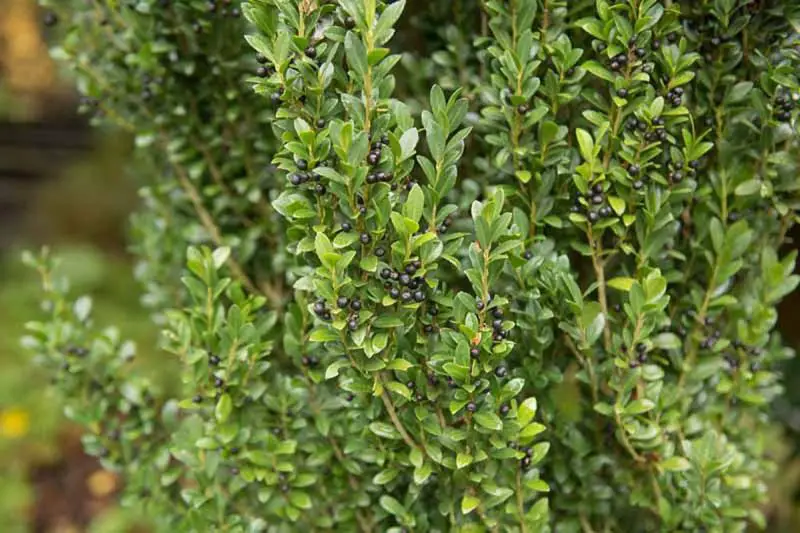
Ilex crenata, or Japanese Holly, is an evergreen shrub that resembles boxwood in appearance but is more tolerant of various growing conditions. It typically reaches 3 to 10 feet in height and has small, glossy, dark green leaves and dense branching. Tiny white flowers bloom in spring, followed by black berries on female plants.
Native to East Asia, Japanese Holly thrives in USDA zones 5 to 8 and prefers full sun to partial shade with well-drained, slightly acidic soil. It is tolerant of pruning, pollution, and urban environments, making it ideal for formal landscapes and topiary.
Commonly used in hedges, foundation plantings, and as a boxwood substitute, Japanese Holly is versatile and easy to maintain. It can be pruned into formal shapes or left natural in borders. Regular trimming and occasional feeding will keep the plant compact and healthy.
Camellia sasanqua (Sasanqua Camellia)
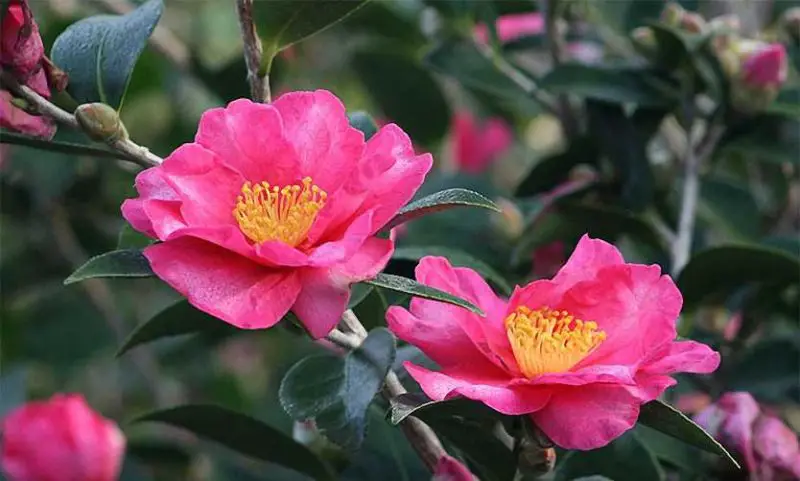
Camellia sasanqua is a graceful evergreen shrub known for its profuse autumn to early winter blooms and glossy dark green leaves. Smaller and more sun-tolerant than its cousin Camellia japonica, it typically grows 4 to 10 feet tall. The flowers can be single or semi-double and come in shades of white, pink, and red, often with a pleasant fragrance.
Native to Japan, this camellia thrives in USDA zones 7 to 9. It prefers acidic, well-drained soil and grows well in partial shade or filtered sun. Once established, it is relatively drought-tolerant. Flowering starts in late fall and continues through winter, providing color during a typically barren season.
Sasanqua Camellias are excellent for foundation plantings, screens, and specimen planting. Their manageable size and upright or spreading growth habits allow them to fit in various landscape styles. Light pruning after blooming keeps them tidy, and mulching helps conserve moisture and maintain soil health.


